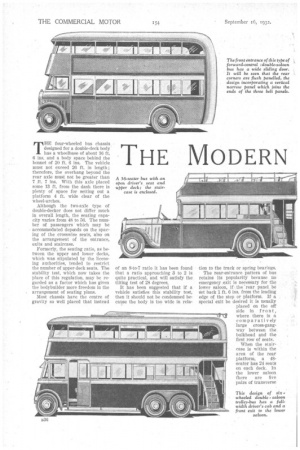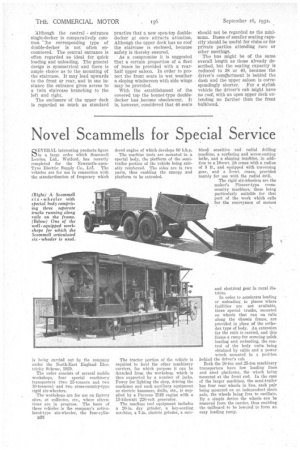THE MODERN DOUBLE-DECKER
Page 62

Page 63

Page 64

If you've noticed an error in this article please click here to report it so we can fix it.
THE four-wheeled bus chassis designed for a double-deck body has a wheelbase of about 16 ft.
6 ins, and a body space behind the bonnet of 20 ft. 6 ins. The vehicle must not exceed 26 ft. in length ; therefore, the overhang beyond the rear axle must not be greater than 7 ft. 7 ins. With this axle placed some 13 ft. from the dash there is plenty of space for setting out a platform 4 ft. wide clear of the wheel-arches.
Although the two-axle type of double-decker does not differ much in overall length, the seating capacity varies from 48 to 56. The number of passengers• which may be accommodated depends on the spacing of the crosswise seats, also on the arrangement of the entrance, exits and staircase.
Formerly, the seating ratio, as between the upper and lower decks, which was stipulated by the licensing authorities, tended to restrict the number of upper-deck seats. The stability test, which now takes the place of this regulation, may be regarded as a factor which has given the bodybuilder more freedom in the arrangement of seating plans.
Most chassis have the centre of gravity so well placed that instead of an 8-to-7 ratio it has been found that a ratio approaching 3 to 2 is quite practical, and will satisfy the tilting test of 28 degrees.
It has been suggested that if a vehicle satisfies this stability test, then it should not be condemned because the body is too wide in rela tion to the track or spring bearings.
The rear-entrance pattern of bus retains its popularity because no emergency exit is necessary for the lower saloon, if the 'rear, panel be Set back 1 ft. 6 ins, from the leading edge of the step or platform. If a special exit be desired it is usually placed• on the off side in front, where there is a comparatively large cross-gangway between the bulkhead and the first row of seats.
When the staircase is within the area of the rear platform, a 48seater has 24 seats on each deck. In the lower saloon ?here are five pairs of transverse seats and two wheel-arch seats, each for two passengers, or these are longer and each accommodates four persons, with one row fewer of transverse seats.
When these are spaced from 2 ft.
4 ins. to 2 ft. ti ins. apart there is seldom room for more ,seats in the lower saloon. In any case, the capacity will not be greater than 20.
With the enclosure of the staircase and the building of the front of the upper saloon, either flush with or within an inch or two of, the driver's windscreen, the upper deck extends for the full length of the vehicle.
The value of so large a saloon is that it has made possible the intro
duction of the staircase into the saloon, and yet leaves space for making up any seating capacity which is thereby lost in the lower saloon. As there is room for a stair-well this may be allocated to an exit or second staircase, with the one for ordinary use mounted, in the usual manner, on the rear platform.
If the double-decker has a front entrance there may be a door at this point, because the entrance need not be so wide as when it is at the rear. Moreover, there is sufficient length for a sliding door to operate or for one of the folding pattern to open across the step.
Both saloons are, therefore, totally enclosed, and there is an opportunity for the introduction of new designs. The bus is really a double saloon, and there is scope for treating the outline boldly.
Double-deckers with two nearside doorways to the lower saloon are of two types. The front doorway may be an exit for both saloons, in conjunction with a second staircase, or this doorway may be used as a service exit only for the lower saloon, such as when the bus is a six-wheeled 60-seater. The exit then relieves the pressure on the rear platform during the rush hours.
Although the central entrance single-decker is comparatively common he corresponding type of double-decker is not often encountered. The central entrance is often regarded as ideal for quick loading and unloading. The general design is symmetrical and there is ample choice as to the mounting of the staircase. It may lead upwards to the front or rear, and in one instance the entrance gives access to a twin staircase branching to the left and right.
The enclosure of the upper deck is regarded so much as standard practice that a new open-top doubledecker at once attracts attention. Although the upper deck has no roof the staircase is enclosed, because safety is thereby ensured.
As a compromise it is suggested that a certain proportion of a fleet of buses be provided with a rearhalf upper saloon. In order to protect the front seats in wet weather a sloping windscreen with side wings may be provided.
With the establishment of the covered top the bonnet-type doubledecker has become obsolescent. It is, however, considered that 46 seats should not be regarded as the minimum. Buses of smaller seating capacity should be useful for clubs or for private parties attending race or other meetings.
The bus might be of the same overall length as those already described, but the seating capacity is reduced to 38 or 40, because the driver's comeartment is behind the dash and the upper saloon is corre spondingly shorter. For a stylish vehicle the driver's cab might have no roof, with an open upper deck extending no farther than the front bulkhead.












































































































